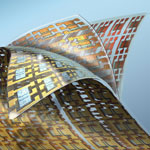Showing Spotlights 177 - 184 of 217 in category All (newest first):
 From an energy savings point of view, the use of smart windows - electrically switchable glass which controls the amount of light passing through when voltage is applied - can save costs for heating, air-conditioning and lighting and avoid the cost of installing and maintaining motorized light screens or blinds or curtains. A disadvantage is of course the fact that the smart windows themselves need to draw energy in order to do their job. Now, researchers have developed a self-powered, fast-switching smart window that doubles as a solar cell, using sun light to power its chromic behavior and making the case for energy savings even more compelling. By employing a patterned tungsten oxide/platinum electrochromic electrode and a dye-sensitized titanium dioxide nanoparticle photoanode, the self-powered photovoltachromic cell (PVCC) which exhibits distinct electrochromic characteristics of a fast switching rate and tunable transmittance under illumination. The novel device has both photoelectrochromic and photovoltaic characteristics.
From an energy savings point of view, the use of smart windows - electrically switchable glass which controls the amount of light passing through when voltage is applied - can save costs for heating, air-conditioning and lighting and avoid the cost of installing and maintaining motorized light screens or blinds or curtains. A disadvantage is of course the fact that the smart windows themselves need to draw energy in order to do their job. Now, researchers have developed a self-powered, fast-switching smart window that doubles as a solar cell, using sun light to power its chromic behavior and making the case for energy savings even more compelling. By employing a patterned tungsten oxide/platinum electrochromic electrode and a dye-sensitized titanium dioxide nanoparticle photoanode, the self-powered photovoltachromic cell (PVCC) which exhibits distinct electrochromic characteristics of a fast switching rate and tunable transmittance under illumination. The novel device has both photoelectrochromic and photovoltaic characteristics.
Oct 27th, 2009
 A couple of years ago we reported on applications of nanotechnology-based processes to the restoration and preservation of priceless artwork. Researchers have shown that nanodispersions of solids, micelle solutions, gels and microemulsions offer new reliable ways to restore and preserve works of art by merging together the main features and properties of soft-matter and hard-matter systems, allowing the synthesis of systems specifically tailored for the works of art to fight the deterioration processes which threaten many priceless masterpieces. Researchers at the University of Florence, who have been leading efforts to apply nanoparticle-based cleaning agents for artwork, have now further developed their work by exploring the design of novel systems containing low amounts of volatile oils as low-impact cleaning tools for the removal of aged polymeric coatings from the surface of paintings.
A couple of years ago we reported on applications of nanotechnology-based processes to the restoration and preservation of priceless artwork. Researchers have shown that nanodispersions of solids, micelle solutions, gels and microemulsions offer new reliable ways to restore and preserve works of art by merging together the main features and properties of soft-matter and hard-matter systems, allowing the synthesis of systems specifically tailored for the works of art to fight the deterioration processes which threaten many priceless masterpieces. Researchers at the University of Florence, who have been leading efforts to apply nanoparticle-based cleaning agents for artwork, have now further developed their work by exploring the design of novel systems containing low amounts of volatile oils as low-impact cleaning tools for the removal of aged polymeric coatings from the surface of paintings.
Oct 26th, 2009
 Eric Drexler replies to yesterday's Spotlight on Feynman and nanotechnology. 'Neither Feynman nor the vision of molecular manufacturing created the fields that have joined to become 'nanotechnology', nor did they provide the concrete scientific opportunities and technological applications that drive it forward. However, what set nanotechnology on its path to prominence was not a sudden realization by the public and politicians that new molecules and nanostructures have a host of applications in materials, sensors, and so on. It was, and is, the promise of revolutionary advances in atomically precise manufacturing, advances that will build on the technology platform now emerging from nanotechnology research.'
Eric Drexler replies to yesterday's Spotlight on Feynman and nanotechnology. 'Neither Feynman nor the vision of molecular manufacturing created the fields that have joined to become 'nanotechnology', nor did they provide the concrete scientific opportunities and technological applications that drive it forward. However, what set nanotechnology on its path to prominence was not a sudden realization by the public and politicians that new molecules and nanostructures have a host of applications in materials, sensors, and so on. It was, and is, the promise of revolutionary advances in atomically precise manufacturing, advances that will build on the technology platform now emerging from nanotechnology research.'
Oct 23rd, 2009
 In December 2009 we will receive a series of reminders of the fiftieth anniversary of Richard Feynman's noted talk, 'There's Plenty of Room at the Bottom'. As commentaries appear in scientific journals, the nanotechnology community will have multiple opportunities to think about the role of Feynman's talk in the history of nanotechnology. Feynman's 1959 talk has been widely hailed as the origin of nanotechnology. It is a comprehensive vision of controlling matter at the nanoscale, including controlling individual atoms. However, at this point, there are two very different views of the role of Feynman's talk in the history of nanotechnology: 1. Everybody knows that Feynman's 'Plenty of Room' is the origin of nanotech. 2. The emergence of nanotech had little to do with Feynman's talk.
In December 2009 we will receive a series of reminders of the fiftieth anniversary of Richard Feynman's noted talk, 'There's Plenty of Room at the Bottom'. As commentaries appear in scientific journals, the nanotechnology community will have multiple opportunities to think about the role of Feynman's talk in the history of nanotechnology. Feynman's 1959 talk has been widely hailed as the origin of nanotechnology. It is a comprehensive vision of controlling matter at the nanoscale, including controlling individual atoms. However, at this point, there are two very different views of the role of Feynman's talk in the history of nanotechnology: 1. Everybody knows that Feynman's 'Plenty of Room' is the origin of nanotech. 2. The emergence of nanotech had little to do with Feynman's talk.
Oct 22nd, 2009
 Nanotechnologies are opening vast new opportunities for scientists, engineers and entrepreneurs to participate in solving some of the major problems facing mankind today. But the road from idea to commercially viable product or process is long. Especially when it comes to nanotech innovations, the research and development phase tends to be relatively lengthy. To help potential nanotechnology start-up founders with shaping their plans, Nanowerk, the leading nanotechnology information service, and Nanostart, the world's leading nanotechnology venture capital company, have teamed up to provide this useful guide which particularly addresses the funding aspects of nanotechnology start-ups, along with answers to some of the most commonly asked questions.
Nanotechnologies are opening vast new opportunities for scientists, engineers and entrepreneurs to participate in solving some of the major problems facing mankind today. But the road from idea to commercially viable product or process is long. Especially when it comes to nanotech innovations, the research and development phase tends to be relatively lengthy. To help potential nanotechnology start-up founders with shaping their plans, Nanowerk, the leading nanotechnology information service, and Nanostart, the world's leading nanotechnology venture capital company, have teamed up to provide this useful guide which particularly addresses the funding aspects of nanotechnology start-ups, along with answers to some of the most commonly asked questions.
Oct 21st, 2009
 Here is the book you all have been waiting for: Nano-Society - Pushing the boundaries of technology. Written by Nanowerk's Michael Berger, this book puts a spotlight on some of the scientists who are pushing the boundaries of technology and it gives examples of their work and how they are advancing knowledge one little step at a time. Nano-Society is the latest addition to RSC Publishing's Nanoscience and Nanotechnology series. Edited by Sir Harry Kroto, Paul O'Brien, and Harold Craighead, the series provides a comprehensive source of information on research associated with nanostructured materials and miniaturized lab-on-a-chip technologies. The book covers 122 very specific research projects that are happening in laboratories around the world and provides commentaries from the scientists in their own words.
Here is the book you all have been waiting for: Nano-Society - Pushing the boundaries of technology. Written by Nanowerk's Michael Berger, this book puts a spotlight on some of the scientists who are pushing the boundaries of technology and it gives examples of their work and how they are advancing knowledge one little step at a time. Nano-Society is the latest addition to RSC Publishing's Nanoscience and Nanotechnology series. Edited by Sir Harry Kroto, Paul O'Brien, and Harold Craighead, the series provides a comprehensive source of information on research associated with nanostructured materials and miniaturized lab-on-a-chip technologies. The book covers 122 very specific research projects that are happening in laboratories around the world and provides commentaries from the scientists in their own words.
Sep 28th, 2009
 Sand. Shrubs. Burst tires. More sand. The last thing you would expect as you drive along the Red Sea near Mecca is to encounter an ultramodern science city. Yet there it is. Appearing after an 80 kilometer drive from Jeddah, Saudi Arabia's second-largest city, the 36 square kilometer campus of King Abdullah University for Science and Technology (KAUST) appears like a Fata Morgana out of the desert sand. Yesterday, September 23rd, King Abdullah of Saudi Arabia officially opened the country's most modern and ambitious university near the old fishing village of Thuwal. Nanowerk was invited to attend the spectacular opening ceremony. Much more than a future elite university, the vision behind KAUST is to create the nucleus of a modern society, free from the strict religious dictates of a conservative Islamic culture, and laying the foundation for a science and technology based society of future generations.
Sand. Shrubs. Burst tires. More sand. The last thing you would expect as you drive along the Red Sea near Mecca is to encounter an ultramodern science city. Yet there it is. Appearing after an 80 kilometer drive from Jeddah, Saudi Arabia's second-largest city, the 36 square kilometer campus of King Abdullah University for Science and Technology (KAUST) appears like a Fata Morgana out of the desert sand. Yesterday, September 23rd, King Abdullah of Saudi Arabia officially opened the country's most modern and ambitious university near the old fishing village of Thuwal. Nanowerk was invited to attend the spectacular opening ceremony. Much more than a future elite university, the vision behind KAUST is to create the nucleus of a modern society, free from the strict religious dictates of a conservative Islamic culture, and laying the foundation for a science and technology based society of future generations.
Sep 24th, 2009
 Sometimes we get bombarded with emails from people who are new to the field about certain aspects of nanotechnology - can it cure cancer? Where can I buy nanobots? What is a nanomaterial? Is nanotechnology dangerous? And so forth. You get the idea. The question asked most often is simply this: 'What is nanotechnology?' That's why we have decided to add a new segment to our Nanowerk website that we call 'Ten things you should know about nanotechnology'. What we have been trying to do here is to provide a brief overview of some important aspects and issues and answer some of the basic questions on nanotechnologies. Of course, there is lots of important information that we omitted. But we feel that, if you are new to nanotechnology, this is a good point to start.
Sometimes we get bombarded with emails from people who are new to the field about certain aspects of nanotechnology - can it cure cancer? Where can I buy nanobots? What is a nanomaterial? Is nanotechnology dangerous? And so forth. You get the idea. The question asked most often is simply this: 'What is nanotechnology?' That's why we have decided to add a new segment to our Nanowerk website that we call 'Ten things you should know about nanotechnology'. What we have been trying to do here is to provide a brief overview of some important aspects and issues and answer some of the basic questions on nanotechnologies. Of course, there is lots of important information that we omitted. But we feel that, if you are new to nanotechnology, this is a good point to start.
Aug 20th, 2009
 From an energy savings point of view, the use of smart windows - electrically switchable glass which controls the amount of light passing through when voltage is applied - can save costs for heating, air-conditioning and lighting and avoid the cost of installing and maintaining motorized light screens or blinds or curtains. A disadvantage is of course the fact that the smart windows themselves need to draw energy in order to do their job. Now, researchers have developed a self-powered, fast-switching smart window that doubles as a solar cell, using sun light to power its chromic behavior and making the case for energy savings even more compelling. By employing a patterned tungsten oxide/platinum electrochromic electrode and a dye-sensitized titanium dioxide nanoparticle photoanode, the self-powered photovoltachromic cell (PVCC) which exhibits distinct electrochromic characteristics of a fast switching rate and tunable transmittance under illumination. The novel device has both photoelectrochromic and photovoltaic characteristics.
From an energy savings point of view, the use of smart windows - electrically switchable glass which controls the amount of light passing through when voltage is applied - can save costs for heating, air-conditioning and lighting and avoid the cost of installing and maintaining motorized light screens or blinds or curtains. A disadvantage is of course the fact that the smart windows themselves need to draw energy in order to do their job. Now, researchers have developed a self-powered, fast-switching smart window that doubles as a solar cell, using sun light to power its chromic behavior and making the case for energy savings even more compelling. By employing a patterned tungsten oxide/platinum electrochromic electrode and a dye-sensitized titanium dioxide nanoparticle photoanode, the self-powered photovoltachromic cell (PVCC) which exhibits distinct electrochromic characteristics of a fast switching rate and tunable transmittance under illumination. The novel device has both photoelectrochromic and photovoltaic characteristics. 
 Subscribe to our Nanotechnology Spotlight feed
Subscribe to our Nanotechnology Spotlight feed





